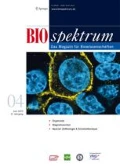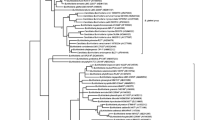Abstract
The discovery of new antibiotics is mandatory with regard to increasing number of pathogen resistances. One approach is the search for new antibiotic producers in nature. At the HZI myxobacteria are successfully isolated and screened for antibiotic production since decades. However, recent studies revealed that only a very small portion of myxobacteria is cultivable. The cultivation of the hitherto uncultivable ones as new potential antibiotic-producers is our biggest challenge.
Similar content being viewed by others
Literatur
Karwehl S, Stadler M (2016) Exploitation of fungal biodiversity for discovery of novel antibiotics. Curr Top Microbiol Immunol 398:303–338
Müller R, Wink J (2014) Future potential for anti-infectives from bacteria–how to exploit biodiversity and genomic potential. Int J Med Microbiol 304:3–13
Mohr K (2016) History of antibiotics research. Curr Top Microbiol Immunol 398:237–272
Hüttel S, Herrmann J, Müller R (2013) Schätze aus dem Boden: innovative Prozesse zur Wirkstofffindung. BIOspektrum 5:520–522
Weissman KJ, Müller R (2010) Myxobacterial secondary metabolites: bioactivities and modes-of-action. Nat Prod Rep 27:1276–1295
Herrmann J, Abou Fayadab A, Müller R (2017) Natural products from myxobacteria: novel metabolites and bioactivities. Nat Prod Rep 34:135–160
Mohr KI, Wink J (2015) Von der Bodenprobe zum neuen Naturstoff. Bodenbakterien als erfolgreiche Antibiotikaproduzenten. GIT Laborjournal 11:14
Schneiker S, Perlova O, Kaiser O et al. (2007) Complete genome sequence of the myxobacterium Sorangium cellulosum. Nat Biotechnol 25:1281–1289
Brinkhoff T, Fischer D, Vollmers J et al. (2012) Biogeography and phylogenetic diversity of a cluster of exclusively marine myxobacteria. Int J Syst Evol Microbiol 6:1260–1272
Mohr KI, Stechling M, Wink J et al. (2016) Comparison of myxobacterial diversity and evaluation of isolation success in two niches: Kiritimati Island and German compost. MicrobiologyOpen 5:268–278
Mohr KI, Zindler T, Wink J et al. (2017) Myxobacteria in high moor and fen: an astonishing diversity in a neglected extreme habitat. MicrobiologyOpen 6:e464
Author information
Authors and Affiliations
Corresponding author
Additional information
Kathrin I. Mohr 1993–2000 Biologiestudium an der TU Braunschweig, dort 2007 Promotion. 2005–2009 DFG- und BMBF-Projekte an der Experimentellen Phykologie und Sammlung von Algenkulturen der Universität Göttingen (EPSAG). Seit 2009 Helmholtz-Zentrum für Infektionsforschung, Braunschweig, in der Abteilung Mikrobielle Wirkstoffe.
Joachim Wink 1977–1985 Biologiestudium an der Universität Frankfurt a. M., dort 1985 Promotion. 1985–1992 Laborleiter der Höchst AG (Biotechnologie der Zentralforschung). 1992–2012 Pharmaforschung Sanofi/Aventis (ehemalige Höchst AG). Seit 2012 Helmholtz-Zentrum für Infektionsforschung, Braunschweig, Leiter der Arbeitsgruppe Mikrobielle Stammsammlung.
Rights and permissions
About this article
Cite this article
Mohr, K.I., Wink, J. Naturstoffproduzenten Myxobakterien: Wir sehen nur die Spitze des Eisbergs. Biospektrum 24, 31–33 (2018). https://doi.org/10.1007/s12268-018-0887-8
Published:
Issue Date:
DOI: https://doi.org/10.1007/s12268-018-0887-8




